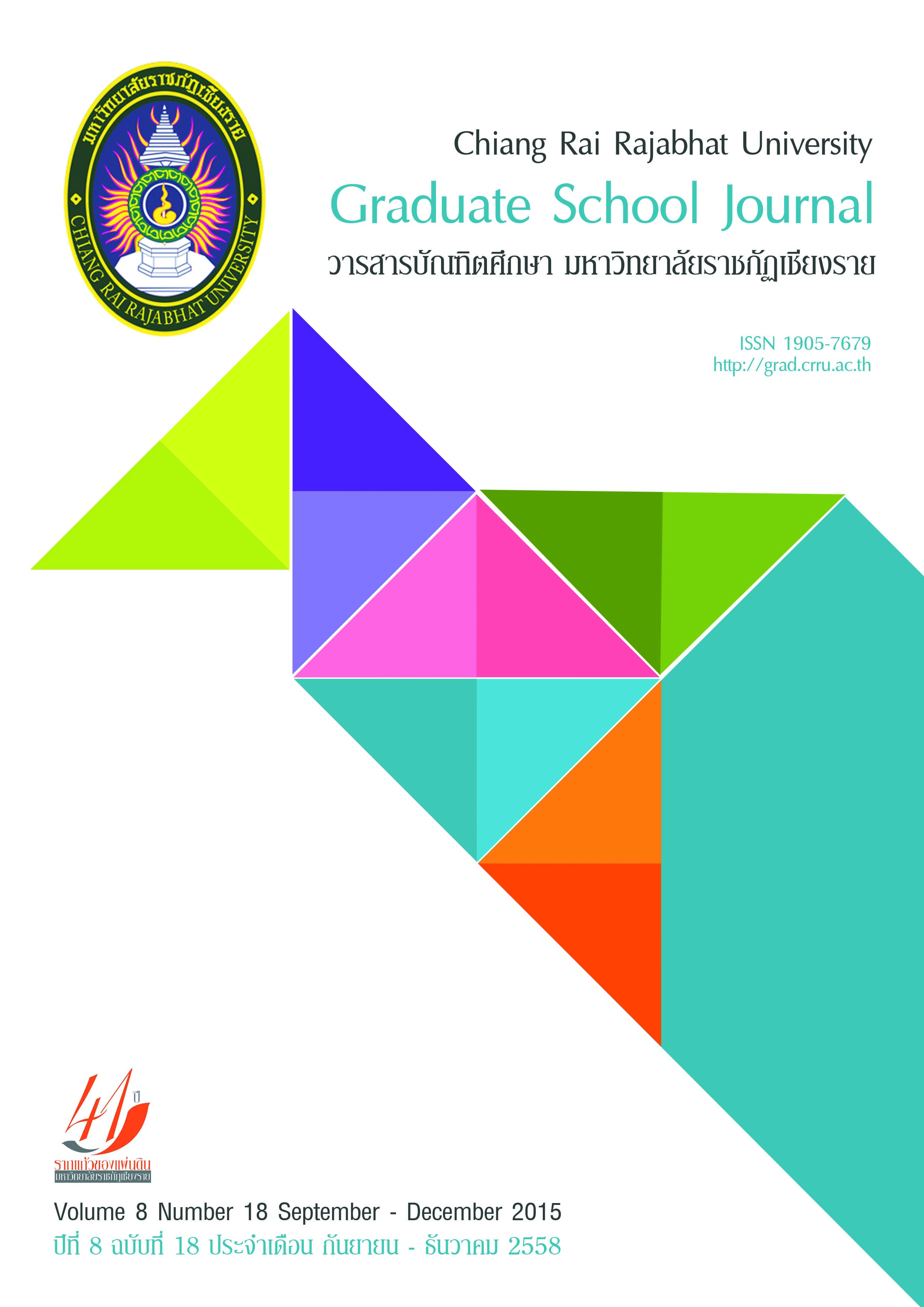ข้อเสนอเชิงยุทธศาสตร์การบริหารจัดการเพื่อพัฒนาสมรรถนะของผู้เรียน ตามหลักสูตรสถานศึกษาที่สอดคล้องกับทักษะการเรียนรู้ในศตวรรษที่ 21 ของโรงเรียนราษฎร์พัฒนา อำเภอแม่ฟ้าหลวง จังหวัดเชียงราย
Main Article Content
Abstract
สภาพและระดับของการดำเนินการการบริหารจัดการเพื่อพัฒนาสมรรถนะของผู้เรียนตามหลักสูตรสถานศึกษาของ โรงเรียนราษฎร์พัฒนา เมื่อพิจารณาตามหลักการการดำเนินการตามหลักการบริหารจัดการ”POLC” ได้แก่ความสามารถด้าน การสื่อสารและความสามารถด้านการคิดและคุณภาพระดับดี ได้แก่ความสามารถด้านการแก้ปัญหาความสามารถด้านการใช้ ทักษะชีวิต ความสามารถด้านการใช้เทคโนโลยี ภาพรวมของการดำเนินการการบริหารจัดการเพื่อพัฒนาสมรรถนะของผู้เรียน ตามหลักสูตรสถานศึกษาของโรงเรียนราษฎร์พัฒนามีคุณภาพระดับดีเหตุและปัจจัยสำคัญที่มีผลต่อการบริหารจัดการเพื่อพัฒนา สมรรถนะของผู้เรียนทั้ง5ด้านสามารถแยกออกเป็น 2 ประเด็นคือ 1) เหตุและปัจจัยประเด็นสนับสนุนเกิดจากด้านผู้บริหารสถาน ศึกษามีภาวะผู้นำสูง ด้านครูและบุคลากรทางการศึกษามีแรงจูงใจและประสิทธิภาพการทำงานสูง ด้านการบริหารจัดการในด้าน ปัจจัยภายนอกสถานศึกษาได้รับการสนับสนุนจากชุมชน 2) เหตุและปัจจัยประเด็นฉุดรั้ง ด้านผู้บริหารสถานศึกษา ด้านครูและ บุคลากรทางการศึกษาในด้านงบประมาณยังไม่เพียงพอในด้านปัจจัยภายนอก ยังคงใช้ภาษาถิ่นในการสื่อสารและสภาพแวดล้อม บริบท ในด้านการบริหารจัดการนั้น ไม่มีการติดตามประเมินผลการพัฒนาสมรรถนะผู้เรียนอย่างต่อเนื่อง
ยุทธศาสตร์การบริหารจัดการเพื่อพัฒนาสมรรถนะผู้เรียนตามหลักสูตรของสถานศึกษาที่สอดคล้องกับทักษะการเรียนรู้ ศตวรรษที่ 21 ของโรงเรียนราษฎร์พัฒนาอำเภอแม่ฟ้าหลวง จังหวัดเชียงรายประกอบด้วย
ยุทธศาสตร์ที่ 1 พัฒนาผู้บริหารสถานศึกษาเพื่อพัฒนาสมรรถนะผู้เรียนที่สอดคล้องกับศตวรรษที่21มีวัตถุประสงค์ เพื่อ พัฒนาความรู้ความเข้าใจเกี่ยวกับการบริหารจัดการเพื่อพัฒนาสมรรถนะผู้เรียนปรับเปลี่ยนวิสัยทัศน์ของผู้บริหารสถานศึกษา พร้อมรับการเปลี่ยนแปลงที่เกิดขึ้น โดยมีเป้าหมายมุ่งที่ผู้บริหารสถานศึกษาประกอบด้วยกลยุทธ์คือ พัฒนาความรู้ด้านการพัฒนา สมรรถนะผู้เรียน และพัฒนาปรับเปลี่ยนวิสัยทัศน์ของผู้บริหารสถานศึกษา
ยุทธศาสตร์ที่ 2 มุ่งเน้นพัฒนาสมรรถนะผู้เรียนอย่างแท้จริงที่สอดคล้องกับทักษะการเรียนรู้ในศตวรรษที่ 21 มี วัตถุประสงค์ เพื่อส่งเสริมการจัดการเรียนรู้ที่ตอบสนองความต้องการของผู้เรียนเพื่อให้เป็นไปตามมาตรฐานการพัฒนาที่ได้กำหนด ไว้โดยเป้าหมายมุ่งที่ผู้บริหารสถานศึกษา/ครูและบุคลากรในสถานศึกษาประกอบด้วยกลยุทธ์คือ กำหนดเป้าหมายความสำเร็จ ของสถานศึกษา โครงการพัฒนาสมรรถนะผู้เรียน และโครงการพัฒนาสมรรถนะครูสู่พัฒนาสมรรถนะผู้เรียน
ยุทธศาสตร์ที่ 3 ส่งเสริมการพัฒนาบุคลากรในสถานศกึ ษาเพื่อสมรรถนะผเู้ รียนที่สอดคล้องกับทักษะการเรียนร้ใู นศตวรรษ ที่ 21 มีวัตถุประสงค์ เพื่อพัฒนาบุคลากรในสถานศึกษาให้สอดคล้องความต้องการของบุคลากรและสถานศึกษาเพื่อให้บุคลากร ได้มีการพัฒนาตนเองอย่างเหมาะสมมีการนำผลจากการพัฒนามาปรับปรุงกระบวนการปฏิบัติงานและมีการแลกเปลี่ยนเรียนรู้ เพื่อพัฒนาสมรรถนะผู้เรียนอย่างมีประสิทธิภาพต่อไปโดยเป้าหมายมุ่งที่ครูและบุคลากรในสถานศึกษากลยุทธ์ประกอบด้วยกลยุทธ์ พัฒนาบุคลากรในสถานศึกษาให้สอดคล้องความต้องการของบุคลากรและสถานศึกษาในการพัฒนาสมรรถนะผู้เรียนที่สอดคล้อง กับทักษะการเรียนรู้ในศตวรรษที่ 21 และกลยุทธ์การแลกเปลี่ยนเรียนรู้เพื่อการพัฒนาสมรรถนะผู้เรียน
ยุทธศาสตร์ที่ 4 ส่งเสริมกระบวนการบริหารจัดการเพื่อพัฒนาสมรรถนะผ้เู รียนที่สอดคล้องกับศตวรรษที่21มีวัตถุประสงค์ เพื่อพัฒนากระบวนการบริหารจัดการเพื่อพัฒนาสมรรถนะผู้เรียนเพื่อให้บรรลุตามเป้าหมายของสถานศึกษา และสร้างระบบให้ เกิดขึ้นในสถานศึกษาเองโดยอาศัยการมีส่วนร่วมของชุมชนในติดตามผลการบริหารจัดการ เป้าหมายมุ่งที่ผู้อำนวยการสถาน ศึกษา/บุคลากรในสถานศึกษาและคณะกรรมการสถานศึกษามีกลยุทธ์การพัฒนากระบวนการบริหารจัดการ
ยุทธศาสตร์ที่กำหนดไว้นั้นแผนกำหนดการการบริหารจัดการเพื่อพัฒนาสมรรถนะของผู้เรียนที่สอดคล้องกับทักษะการ เรียนรู้ในศตวรรษที่ 21 ไว้ 5 ระยะ คือระยะที่ 1เริ่มต้นวิเคราะห์ (ภายในภาคเรียนที่ 1 ปีการศึกษา 2558) ระยะที่ 2 จัดประสบการณ์ (ภายในภาคเรียนที่ 2 ปีการศึกษา 2558) ระยะที่ 3รายงานผล (ภายในภาคเรียนที่ 2 ปีการศึกษา2558) ระยะที่ 4 นำสู่นวัตกรรม (ภายในภาคเรียนที่ 1 ปีการศึกษา 2559) ระยะที่5นำสู่การเรียนรู้ที่ยั่งยืน(ภายในภาคเรียนที่ 2 ปีการศึกษา 2559) กำหนดการ นับเป็นเดือนเพื่อการใช้ยุทธศาสตร์
The Strategy of Administration to Develop Students’ Ability as Rathpattana School’s Curriculum Mae FahLuang district in Chiangrai
This research was the institutional research using mixed methodology for collecting data in qualitative and quantitative method. The purposes of this research were: 1) to study the condition and quality level of the administrative operation to develop students’ competency based on the school curriculum; 2) to find out the important causes and factors affecting the quality of the administrative operation to develop students’ competency based on the school curriculum, and; 3) to present the strategy for administration to develop students’ competency based on school curriculum in accordance with the 21st century education of Rajpattana School in Mae Fah Luang district, Chiang Rai province. The population was administrators and teachers. Tools used for this research were open-ended questionnaire, questionnaire and causes and effect analysis record. The data was analyzed by using content analysis and administration strategy was implemented by brainstorming technique. The research results were concluded as follows:
Regarding the condition and level of the administrative operation to develop students’ due to “ POLC ” strategic management in terms of communication and thinking ability were at a very good level. The overall condition of the administrative operation and in terms of problem solving, life skills, and IT literacy were also at a good level.
The causes and factors affecting the administration to develop 5 aspects of students’ competency could be divided into two issues as follows: 1) Supporting causes and factors were school’s executives had high leadership; teachers and educational personnel had high motivation and work efficiency as well as the administration on the external factor or outside of school appeared that the school was supported by community; 2) Pull causes and factors consisted of school’s executives, teachers and educational personnel, and insufficient budget. For external factors, there were still using dialect for communication and context environment and for administration, there were no monitoring and evaluation on the development of students’ capacity continuously. The strategies of administration to students’ competency based on school curriculum in accordance with the 21st century learning skills of Rajpattana school, Mae Fah Luang district, Chiang Rai province consisted of the following:
Strategy I: Developing school’s executives to develop students’ competency based on school curriculum in accordance with the 21st century learning skills with the purposes to develop cognition of the administration to develop students’ competency and to adjust visions of school’s executives to be ready for changing, targeting at school’s executives. The strategies were the development of knowledge of developing students’ competency and the development and adjustment visions of school’s executives.
Strategy II: Emphasizing on the development of students’ competency truly in accordance with the 21st century learning skills with the aims to promote the learning management responding to students’ demand accorded to the standard of development defined, targeting at school’s executives, teachers and personnel in school. The strategies composed of determination the goal of school’s success, the project of students’ competency development, and the project of teachers’ competency development toward students’ competency development.
Strategy III: Promoting personnel-in-school development for students’ competency in accordance with the 21st century learning skills with the purposes to develop personnel in school to be accorded to the demand of personnel and school, to allow personnel to develop oneself properly, to use the development results for improving the operation procedure, and to exchange knowledge for further developing students’ competency efficiently, targeting at teachers and personnel in school. The strategies composed of the personnel in school development to be accorded to the demand of personnel and school in developing students’ competency in accordance with the 21st century learning skills and the knowledge sharing strategy for students’ competency development.
Strategy IV: Promoting the administration procedure to develop students’ competency in accordance with the 21st century learning skills with the purposes to develop the administration procedure for developing students’ competency, to achieve school’s goal, and to create the autonomous system in school depending on the community participation in terms of the follow up of the administration. The target group was school’s director, personnel in school, and school’s committee by using the strategy of the administration procedure development.
The 5-phase strategies plan of administration were designed to develop students’ competency in accordance with the 21st century learning skills as follows: Phase I begins with the analysis within semester 1 in the academic year 2015; Phase II manages the experience within semester 2, in the academic year 2015; Phase III reports the results within semester 2 in the academic year 2015; Phase IV leads to the innovation within semester 1 in the academic year 2016, and; Phase V leads to the sustainable learning within semester 2 in the academic year 2016. The Schedule will be counted in month for using the strategies.
Article Details
บทความที่ได้รับการตีพิมพ์เป็นลิขสิทธิ์ของวารสารมหาวิทยาลัยราชภัฎเชียงราย
ข้อความที่ปรากฏในบทความแต่ละเรื่องในวารสารวิชาการเล่มนี้เป็นความคิดเห็นส่วนตัวของผู้เขียนแต่ละท่านไม่เกี่ยวข้องกับมหาวิทยาลัยราชภัฎเชียงราย และคณาจารย์ท่านอื่นๆในมหาวิทยาลัยฯ แต่อย่างใด ความรับผิดชอบองค์ประกอบทั้งหมดของบทความแต่ละเรื่องเป็นของผู้เขียนแต่ละท่าน หากมีความผิดพลาดใดๆ ผู้เขียนแต่ละท่านจะรับผิดชอบบทความของตนเองแต่ผู้เดียว

